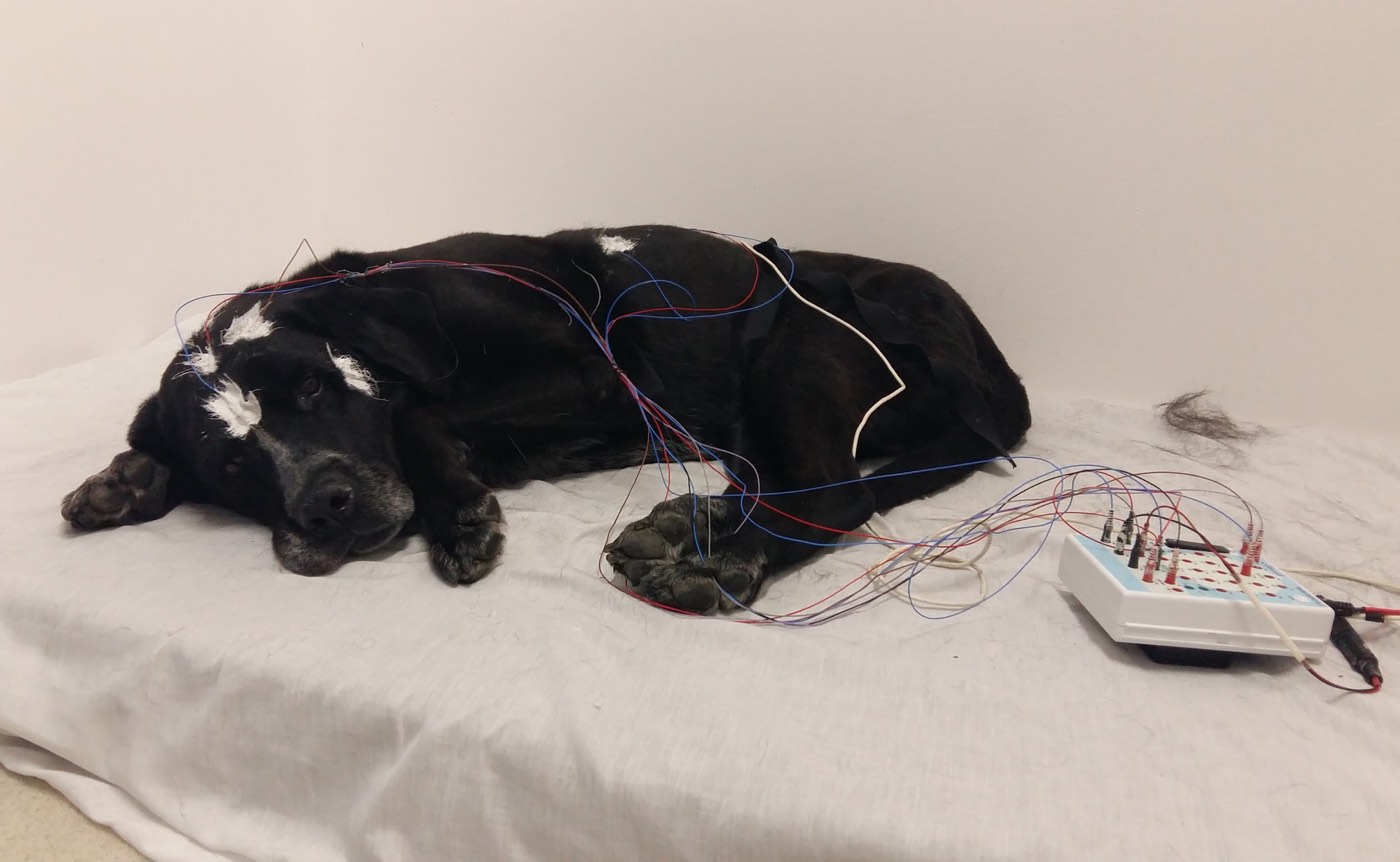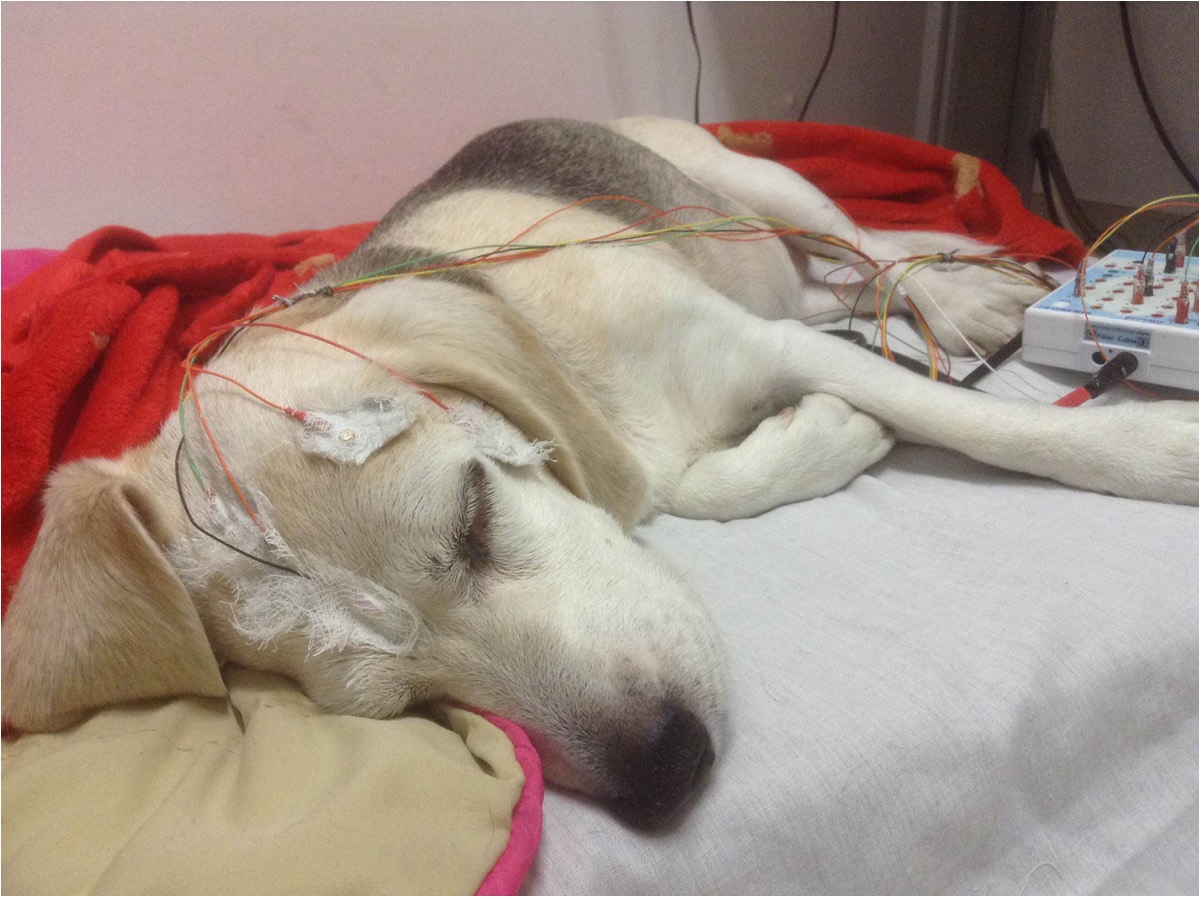Let Sleeping Dogs Lie: It Helps Them Consolidate Memories

Want to teach an old dog new tricks? Try letting your pet take a nap. New research finds that dogs consolidate new memories in sleep, just like humans do.
The study used electroencephalography (EEG), a technique that measures electrical activity in the brain via the scalp, to track snoozing dogs' brain activity. Similar to humans, the dogs showed short bursts of activity, called sleep spindles, during non-rapid-eye-movement sleep. Also as in humans, the frequency of these sleep spindles was linked to how well a dog retained new information it had learned before its nap.
"It's the first time that we can actually show this in a dog," said study co-author Ivaylo Iotchev, a doctoral student at Eötvös Loránd University in Budapest, Hungary. [20 Weird Dog and Cat Behaviors Explained by Science]
Sleep spindles
Most in-depth sleep research, Iotchev said, has focused on humans and rodents, specifically mice and rats. Seeing the parallels between dog sleep and human sleep is interesting, he told Live Science, because dogs are actually more distantly related to humans than mice are, evolutionarily speaking.
Sleep spindles are also an interesting area of research because they're related to learning and memory, Iotchev said. Sleep spindles are bursts of electrical activity in the brain that last about half a second, with a frequency of about 12 to 14 hertz in humans. These bursts block information from the thalamus, a chunk of gray matter in the forebrain that acts to relay sensory information, from reaching the cortex for more sophisticated processing.
"When sleep spindles happen, the brain is being shielded from outside information," Iotchev said, "which is very important for memory consolidation, because when you want to remember something, you don't want it to mix with outside information." [5 Interesting Facts About Sleep]

Not much is known about this process in dogs, even though dogs are sometimes used as medical models for human brain disease, especially epilepsy. Until now, Iotchev said, dog EEG research focused mostly on whole-brain activity, like the transition from sleep to wakefulness. But sleep spindles specifically change with age, so understanding them can both help to improve veterinary medicine in elderly dogs and possibly reveal how similar the process of aging in dog brains is to that in human brains, Iotchev said.
Sign up for the Live Science daily newsletter now
Get the world’s most fascinating discoveries delivered straight to your inbox.
New tricks
To examine sleep spindles in dogs, the researchers asked 15 dog owners to bring their pooches in for three separate sessions. The dogs represented a variety of breeds, ranging from mutt, to Labrador retriever, to miniature schnauzer. All of the dogs first took a snooze while researchers recorded the canines' baseline brain activity with EEG. Next, the dogs were randomly assigned to practice commands they already knew in Hungarian or to learn those same actions but with unfamiliar English words ("sit" and "lie down"). Seven of the dogs did the practice task in Hungarian first and then the new training in English. The eight completed the activities in the opposite order. [Like Dog, Like Owner: What Breeds Say About Personality]

After each session, whether in Hungarian or English, the dogs got the chance to zonk out while the researchers recorded their brain activity. Linking the pattern of brain waves to actual learning was a key part of the study, Iotchev said, so after the nap, the dogs learning English commands did another session to show how well they'd retained the training.
Sleep spindles, the researchers found, look much the same in dogs as they do in humans. They're twice as frequent in female dogs as in male dogs, which matches the pattern seen in humans: Women have more sleep spindles than men thanks to the influence of sex hormones, Iotchev said.
Dogs with more frequent sleep spindles during a snooze session also proved to be better learners than dogs with less frequent sleep spindles, the researchers found. Again, this result tracks with findings in humans and rodents.
People with depression have more frequent sleep spindles than average, Iotchev said, and people with schizophrenia have less. Thus, these activity bursts may provide a window into the similarities in brain dysfunction between dogs and humans. For example, some researchers use dogs to try to understand attention deficit hyperactivity disorder (ADHD), Iotchev said. If humans with ADHD have atypical sleep spindles (and some research indicates they may), researchers would want to look to see if dogs show the same sort of aberrations. If they do, it would indicate that some of the same brain processes underlie ADHD in both humans and dogs. If they don't, dogs might not be the best models for that disorder. Iotchev and his team are especially focused on relating their findings to aging.
"The next step is, we will look at a huge sample of dogs to see how sleep spindles change with age," he said.
The researchers published their findings Oct. 11 in the open-access journal Scientific Reports.
Original article on Live Science.

Stephanie Pappas is a contributing writer for Live Science, covering topics ranging from geoscience to archaeology to the human brain and behavior. She was previously a senior writer for Live Science but is now a freelancer based in Denver, Colorado, and regularly contributes to Scientific American and The Monitor, the monthly magazine of the American Psychological Association. Stephanie received a bachelor's degree in psychology from the University of South Carolina and a graduate certificate in science communication from the University of California, Santa Cruz.









